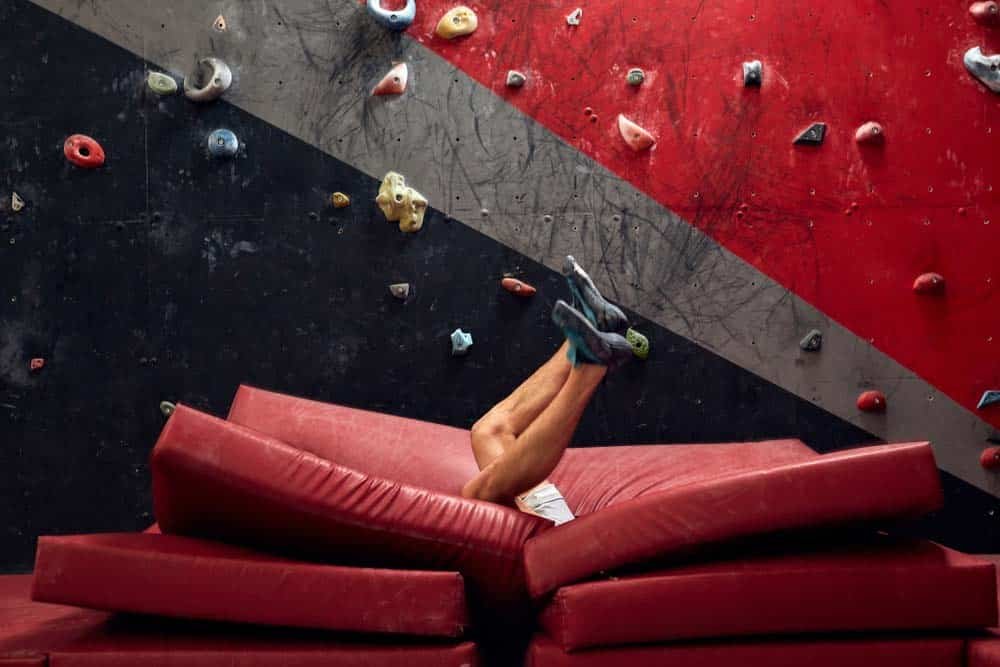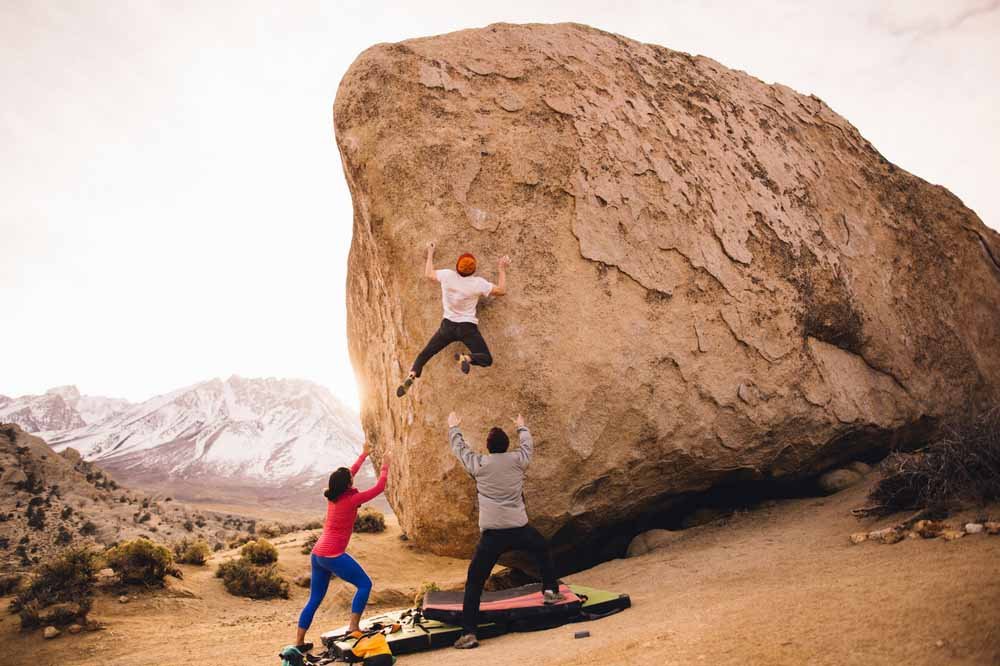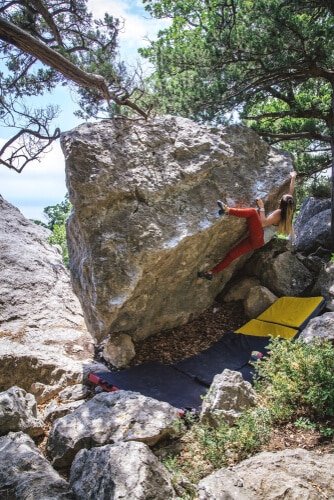For many, bouldering is the introduction to the sport of climbing. It’s certainly climbing’s most affordable and straightforward discipline. You’re only a few feet off the ground. No gear, no ropes, no harness, no helmet… No problem, right? All you need to boulder are pads, rock shoes, and some chalk.
This is true, but doesn’t mean bouldering is entirely safe. In fact, a study in the Wilderness & Environmental Medicine Journal and a recent evaluation with the International Journal of Environmental Research and Public Health found that bouldering resulted in more injuries than any other climbing discipline.
Per these studies, more than 80% of boulderers experience a bouldering injury in their climbing career (compared to 50% for traditional and sport climbers). That said, the common injuries were relatively minor, affecting fingers, shoulders, and ankles.
So it’s important to note that while injuries while bouldering are more common than other climbing disciplines, they are overwhelmingly less serious, and often result not from falls but from strain. The studies found that “spotting other boulderers resulted in few injuries, but both climbing and falling were associated with diffuse injuries,” and concluded that there were “few differences between indoor and outdoor boulderers” in terms of accidents.
In the grand scheme of things, bouldering is one of climbing’s safer disciplines. It’s almost impossible to kill or seriously injure yourself as a beginner boulderer. You’re only a few feet off the ground. But minor injuries do occur at a higher rate than other disciplines. That’s why falling technique is so important. In this article, we’ll learn how to practice falling, discuss bouldering pads, and offer a few tips for safer bouldering falls.
Bouldering Falling Basics: Proper Fall Technique

There is no surefire way to fall when bouldering, because no two falls are exactly the same. You may fall while stemming or while hooking or while trying to mantle. You may fall on a slab or on a roof or a crack. You may fall onto a flat landing zone, or a hillside that’s as uneven and rocky as a handful of crumbled-up crackers.
You get the idea.
The important thing is to be loose and flexible as you fall, to land feet first, and to dispel momentum through a dynamic landing.
Let’s go through some basic falling technique so you can have safer bouldering falls.
Before the Fall

Once you know you’re going to fall, commit completely. Don’t try to grab holds or “half-fall” and pull back onto the climb. The moment you peel off, you need to be loose, limber, and thinking ahead to your landing.
During the Fall

Safe falling technique revolves around a paradox. You have to be both loose and engaged. You need to remain in control, because you don’t want to ragdoll or be falling flat on your back. But tensing up too much is a fast track to injury. As you become a more experienced boulderer and have more and more falls this will begin to come naturally, but at first, just try to remain calm and keep your muscles as relaxed as possible.
NOTE: Looking down while falling is helpful for two reasons. For one, it lets you scope out the ground below, your landing zone. Also, when you tuck your chin into your chest it naturally tenses your neck muscles, preventing whiplash.
The Landing

The best way to land is with feet shoulder-width apart, impacting the mat squarely and at the same time, so the balls, heels, toes, and side of the foot all absorb impact and provide the most stable stance. Keep your joints loose and knees bent, absorbing as much of the force as possible.
Depending on the height of the fall and the landing you’ll also want to tuck in and roll backward or to the side to disperse momentum and force. This “bouldering roll” is a no-brainer in an indoor gym with unlimited mat coverage. It will significantly disperse impact and minimize risk of injury. Outdoors it’s a bit less advisable, as you may roll off the mat and into an obstacle, hard rock, or other uncomfortable terrain.
Keep Arms and Legs Inside the Car
Mid-landing many climbers have the natural instinct to put out their hands or arms to catch themselves. This is a fast track to injuries. Keep your arms hugged close to your chest, and use your bent knees, body positioning, rolling technique, and the pad to absorb the force of the fall, not your limbs.
Bouldering Pads

Crash pads are as diverse as any other piece of climbing gear. You have different foam types, sizes, thicknesses, folding systems, and special features like harnesses, zipper pockets, and points to lock pads together.
Pads deserve an article in and of themselves, but as it relates to falling, let’s just say the #1 way to maximize your safety when climbing is to ensure your landing is properly protected with crash pads.
Leave no surface unpadded. There should be no cracks or gaps between your pads. Don’t worry about stacking pads on top of each other to minimize these cracks or gaps, even if that makes the pad surface uneven.
When thinking about where to put your crash pads, the process is simple. Think about how likely you are to fall in a certain place, and multiply this by the consequence of that fall. You want pad coverage maximized where this equation is highest. In other words, you want the biggest, firmest pad at the highest point you’re most likely to fall from (firmer pads absorb bigger falls better).
This isn’t always a surefire decision. Unless you’re a professional boulderer, you probably don’t have six or seven pads of varying shapes, thicknesses, and sizes to protect every inch of your landing. So you have to make choices. Just try to protect the highest consequence fall area as much as possible.
NOTE: Some pads move when stepped or fallen on. Be ready to reset your landing area after each attempt, so you avoid landing in a crack or gap that just opened up in your system.
Spotting

Spotting is an art in and of itself, and we could write a whole article on that topic. But above all else, make sure your spotters are active, communicative, and have a plan.
Scan the landing and the route beforehand (more on that below) and talk with your spotters about where you think you’ll fall and when. If the problem you’re attempting requires you to move pads mid-problem, make sure you’re on the same page with your spotters about where and when those pads should move.
Tips for Safer Bouldering Falls

Check the Landing
A careful analysis of your landing will go a long way toward preventing injuries. First, your landing zone should be clear and free of anything that could cause an injury. This includes natural debris like rocks and branches as well as water bottles, car keys, chalk bags, rock shoes, and backpacks. For obvious reasons, you want to avoid landing on or near these things. Anywhere you could possibly land you should have only pads and/or spotters. Nothing more.
Check the Route

Very few boulder problems are straight up-and-down affairs. There will be some lateral motion involved (if not dynos and other more complex movements). So it’s also important to look at the direction of the climb you’re attempting and the individual moves. Try to imagine how and where you might fall. Position pads and spotters accordingly.
Go Light
Climbing light is always a good idea, but it’s especially true when bouldering. Remove any and all jewelry, belts, watches, and other accessories, as well as anything heavy or sharp in your pockets like car keys, phone, and wallet. It might not seem like a big deal, but if you fall 10 feet and land on your car keys, you’ll regret it.
Pads, Pads, Pads

Past a certain point, extra spotters milling around the bouldering area will provide diminishing returns (or simply be a nuisance), but there is no reason not to use as many pads as possible to protect a boulder problem. If you have ’em, use ’em!
Whether you’re layering up thin pads on top of each other or simply laying extra pads outside the immediate fall zone in case of a major roll backward or to one side, extra crash pads will always come in handy.
Watch Videos
Developing good falling techniques for safer bouldering falls takes time. Ultimately, you just have to get out there and climb (and fall). Another way to help is to scan the web for videos of other climbers and see how they fall when bouldering.



